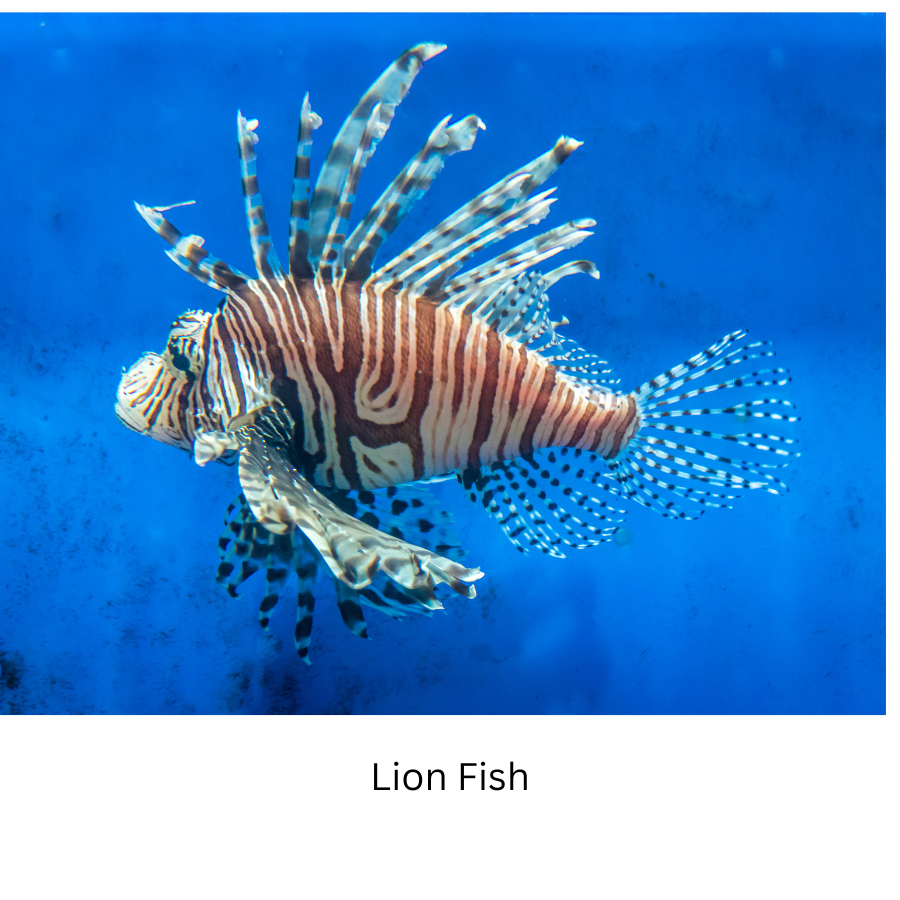
Invasive Lionfish
Share
The invasive Lionfish (Pterois volitans and Pterois miles) has become a significant ecological threat in the Atlantic Ocean, Gulf of Mexico, and Caribbean Sea. Native to the Indo-Pacific region, these striking but harmful predators are now a primary concern for marine ecosystems in non-native waters.
Identification
Lionfish are easily recognizable by their vibrant red, white, and brown striped bodies and long, venomous spines. They typically grow up to 15 inches in length, though some individuals can reach up to 18 inches. Their unique appearance, coupled with their slow, graceful movements, makes them a popular attraction in the aquarium trade, inadvertently contributing to their spread.
Habitat and Behavior
Lionfish inhabit a variety of marine environments, including coral reefs, rocky outcrops, and seagrass beds. They are highly adaptable and can thrive in depths ranging from shallow waters to over 300 feet. Lionfish are solitary and territorial predators, often found hiding in crevices during the day and actively hunting at night.
Ecological Impact
The introduction of Lionfish to non-native waters has led to severe ecological consequences. As voracious predators, they consume a wide variety of reef fish and crustaceans, including species crucial for maintaining the health of coral reefs. Their feeding habits can lead to significant declines in native fish populations, disrupting the balance of the ecosystem and hindering reef recovery and resilience.
Fishing for Lionfish
Fishing for Lionfish has gained popularity as a means to control their population and reduce their impact on native species. Divers and spear fishers commonly target Lionfish, as traditional fishing methods are less effective due to their habitat preferences. Lionfish derbies and spearfishing tournaments are organized in many regions to encourage their removal.
Controlling the Invasion
Efforts to manage the Lionfish invasion include public education, targeted removal programs, and promoting Lionfish as a sustainable seafood option. Encouraging consumers to eat Lionfish can help create a market demand that supports population control. Additionally, research into natural predators and biological control methods is ongoing to find long-term solutions.
Conclusion
The invasive Lionfish presents a serious threat to marine ecosystems in the Atlantic, Gulf of Mexico, and Caribbean. By understanding their characteristics, habitat preferences, and ecological impact, we can take proactive measures to manage and mitigate their presence. Promoting responsible fishing practices and increasing public awareness are essential steps in protecting our marine environments from this invasive species.
"Curious about the latest culinary adventure making waves? Check out our eye-opening article on how chefs are hunting the invasive Lionfish and serve it as a mouthwatering delicacy at restaurants. Discover how this delicious dish is not only a taste sensation but also helping to protect our oceans. Don’t miss the story behind this sustainable seafood trend—your next meal could help save the planet!"
